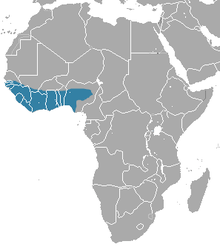Gambian mongoose
The Gambian mongoose (Mungos gambianus) is a mongoose species native to the Guinean forest-savanna mosaic from Gambia to Nigeria. It is listed as Least Concern on the IUCN Red List since 2008.[1]
| Gambian mongoose | |
|---|---|
| Scientific classification | |
| Kingdom: | Animalia |
| Phylum: | Chordata |
| Class: | Mammalia |
| Order: | Carnivora |
| Suborder: | Feliformia |
| Family: | Herpestidae |
| Genus: | Mungos |
| Species: | M. gambianus |
| Binomial name | |
| Mungos gambianus Ogilby, 1835 | |
 | |
| Gambian mongoose range | |
Appearance
The Gambian mongoose is generally a brownish-grey colour on the dorsal fur, becoming more rufous towards the legs blending into the red fur on the ventral surface. They have a dark streak of fur on the sides of its light-colored neck. The short, tapered tail is not bushy. They have five toes on each foot, which is bare from the sole to the wrist and heel. Their faces are short, and have only two molars on each jaw. There is no noticeable sexual dimorphism. Females have six mammae.[2]
Distribution and habitat
The Gambian mongoose is endemic to West Africa where it can be found in the mesic savannas and woodlands from Senegal and Gambia in the west east to Nigeria.[1]
Diet
The Gambian mongoose is an opportunistic feeder, eating a wide variety of foods. They are primarily insectivorous, eating mostly beetles and millipedes. They will also eat small rodents and reptiles, and sometimes eggs.[2]
Habits
The Gambian mongoose is diurnal, gregarious and terrestrial. They live in groups of 10-20 individuals, but groups have been known to number over 40. The groups consist of adults of both sexes, who forage together. Encounters between animals of different groups are often noisy, with a lot of fighting between the neighbors. This mongoose is very vocal, communicating with a variety of sounds. A call that sounds like a bird twitter is used to keep the group together while foraging. A louder, higher pitched twitter is used to indicate danger.[2]
Reproduction
Breeding occurs at any time of the year, with more young born during the rainy season. All the females in the group reproduce at around the same time. Groups can breed up to four times a year, but individually the females do not breed as frequently. Mating occurs 1–2 weeks after the young are born. Mongooses often breed with others of another group, but most stay within the group. While the mother forages for food, two males stand guard at the den's entrance. This mongoose practices communal suckling; cubs suckle from any lactating female. The young are weaned at the age of about one month, and at this time they join the group in foraging.[2]
References
- Sillero-Zubiri, C. & Do Linh San, E. (2016). "Mungos gambianus". IUCN Red List of Threatened Species. 2016: e.T13922A45199653. Retrieved 17 August 2019.
- "Mungos gambianus". Animal Diversity Web. Regents of the University of Michigan. Retrieved 2016-11-25.
